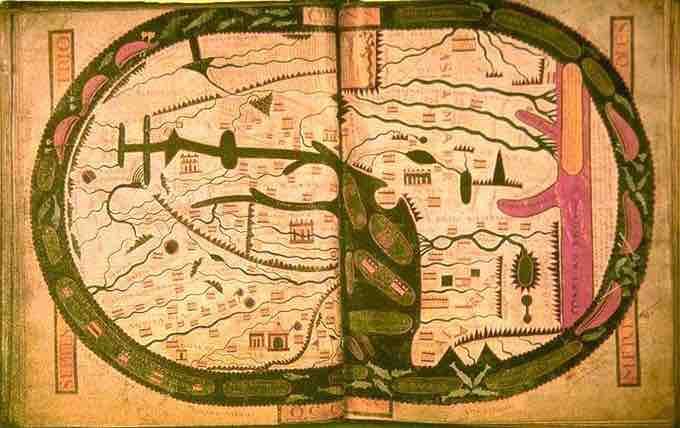The Commentary on the Apocalypse was originally a Mozabaric eighth-century work by the Spanish monk and theologian Beatus of Liébana. Often referred to simply as the Beatus, it is used today to reference any of the extant manuscript copies of this work, especially any of the twenty-six illuminated copies that have survived. The historical significance of the Commentary is made even more pronounced since it included a world map, offering a rare insight into the geographical understanding of the post-Roman world . Considered together, the Beatus codices are among the most important Spanish and Mozarabic medieval manuscripts, and have been the subject of extensive scholarly and antiquarian enquiry.

Beatus World Map
The world map from the Saint-Sever Beatus, measuring 37 x 57 cm. This was painted c. 1050 A.D. as an illustration to Beatus's work at the Abbey of Saint-Sever in Aquitaine, on the order of Gregori de Montaner, Abbot from 1028 to 1072 A.D.
Though Beatus may have written these commentaries as a response to Adoptionism in the Hispania of the late 700s, many scholars believe that the book's popularity in monasteries stemmed from the Arabic-Islamic conquest of the Iberian peninsula, which some Iberian Christians took as a sign of the Antichrist. Not all of the Beatus manuscripts are complete, and some exist only in fragmentary form. However, the surviving twenty-six of these manuscripts are lavishly decorated in the Mozarabic, Romanesque, or Gothic style of illumination.
Mozarabic art refers to art of Mozarabs, Iberian Christians living in Al-Andalus who adopted Arab customs without converting to Islam during the Islamic invasion of the Iberian peninsula (from the eighth through the eleventh century). Mozarabic art features a combination of (Hispano) Visigothic and Islamic art styles, as in the Beatus manuscripts, which combine Insular art illumination forms with Arabic-influenced geometric designs .

Beatus Manuscripts
Beatus of Facundus: Judgement of Babylon.